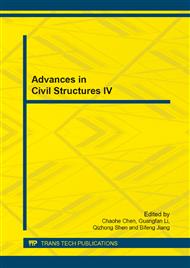p.1161
p.1170
p.1177
p.1183
p.1190
p.1196
p.1200
p.1204
p.1208
Non-Structural Cracking Analysis of Early Age of Basement Structure Based on Field Monitoring
Abstract:
Cracking of basement structure are common problems in civil building, so it’s most import and difficult to inhibiting cracking of building structures. In this paper, real-time continuous monitoring data of strain and temperature were obtained by embedding sensors in practical engineering, including slab and sidewall of reinforcement concrete, while ambient conditions were monitored to assess their effects. The cracking mechanism of such kind of structure was analyzed based on the investigation and monitoring data. The results show that sidewall is easier to crack than slab for basement structures of civil building, therefore, sidewall cracking of basement structure is the most difficult and key point to inhibit cracking. The measures adopted in this project can effectively reduce crack risk of structure. At the same time, the measured data can provide useful reference to control crack for similar projects and research, and they can also be used to verify the numerical results.
Info:
Periodical:
Pages:
1190-1195
Citation:
Online since:
July 2014
Authors:
Keywords:
Price:
Сopyright:
© 2014 Trans Tech Publications Ltd. All Rights Reserved
Share:
Citation:


